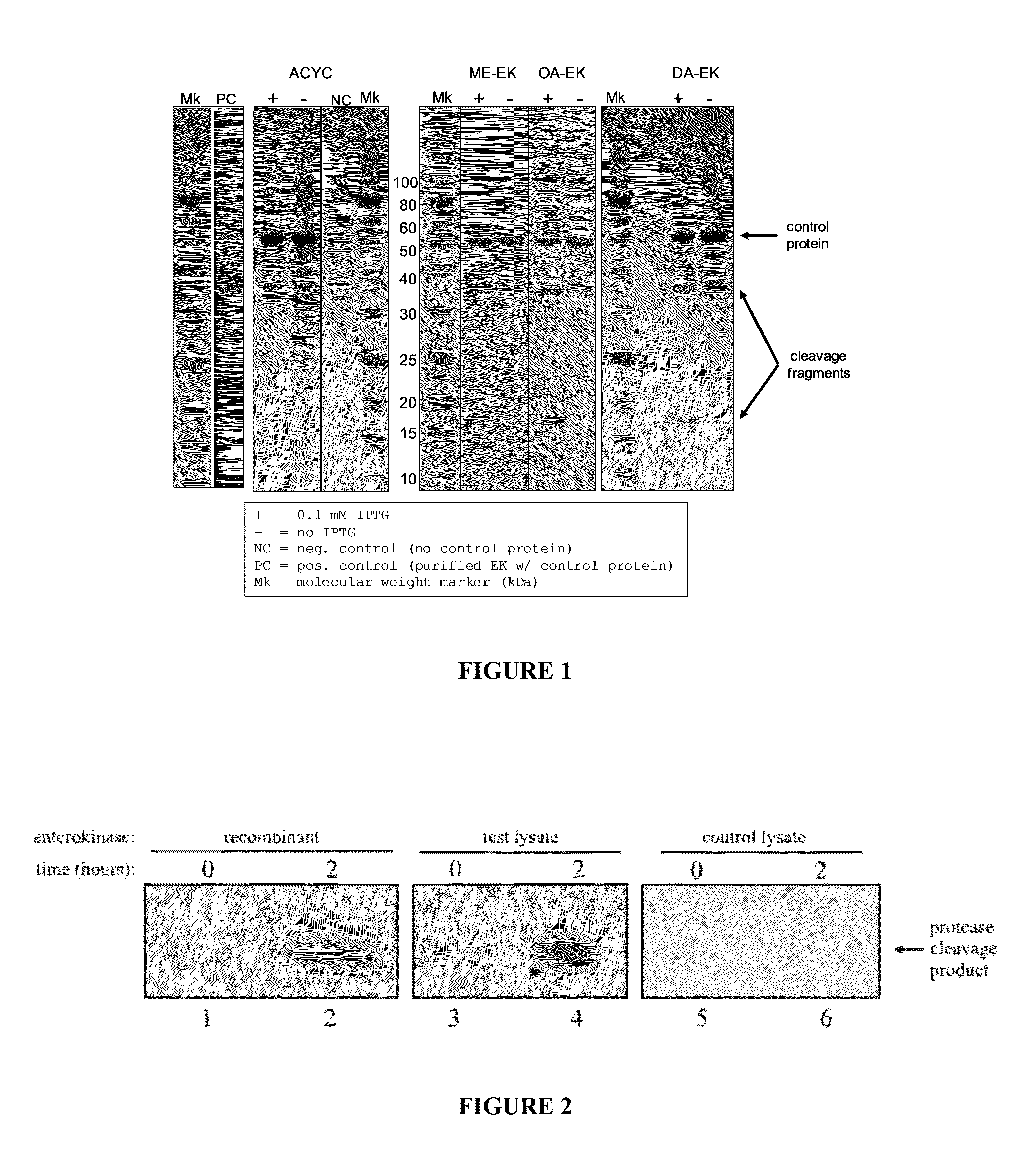Methods for control of flux in metabolic pathways through protease manipulation
a metabolic pathway and protease technology, applied in the field of metabolic pathway flux control through protease manipulation, can solve the problems of undesirable target enzymes, inability to cleave, and inability to target enzymes, and achieve the effect of increasing the rate of precursors
- Summary
- Abstract
- Description
- Claims
- Application Information
AI Technical Summary
Benefits of technology
Problems solved by technology
Method used
Image
Examples
example 1
Protease Segregation to Periplasm
[0214]A library of plasmids is constructed containing several protease genes with various periplasmic signal sequences targeting the protease enzymes to the periplasm. For example, five specific proteases and six periplasmic signal sequences could be combined to make a library of thirty members.
[0215]Nucleotide sequences coding for periplasmic signal sequences are added to each protease gene through polymerase chain reaction (PCR) amplification. Alternatively, the protease genes are synthesized to contain the periplasmic leader signal sequence. Complete synthesis enables codon optimization for efficient expression in the host strain. Suitable proteases and periplasmic targeting / leader sequences are described above in Tables 2 and 3, respectively.
[0216]The library of periplasmically-targeted protease genes is subcloned into a pDuet vector, or other suitable vector, for inducible expression. E. coli strain BL21(DE3), or similar strain expressing the T7...
example 2
Expression and Activity of Periplasmically-Targeted Enterokinase
[0230]Plasmids, cell growth and expression. The gene coding for bovine enterokinase (Genbank Accession L19663.1) was chemically synthesized with codon content optimized for expression in E. coli and with the following periplasmic signal sequences:
[0231]
TABLE 5Periplasmic signal sequencesDsbAatgaaaaagatttggctggcgctggctggtttagttttagcgttta(DA)gcgcatcggcg(SEQ ID NO: 17)OmpAatgaaaaaaacggcaattgcgatagcggttgcgctagctggttttg(OA)ccacggtggcgcaggct(SEQ ID NO: 18)MalEatgaaaataaaaacaggtgcacgcatcctcgcattatccgcattaa(ME)cgacgatgatgttttccgcctcggctctcgcc(SEQ ID NO:19)
[0232]These constructs were subcloned into pACYC-Duet (EMD Chemicals, Gibbstown, N.J.), and E. coli strain BL21(DE3) was transformed with the resulting plasmids. 250 ml cultures were grown from glycerol stocks for 6 h at 37° C. and 300 rpm in EZ rich medium with 34 μg / ml chloramphenicol (cam) to an optical density (OD600) of 0.6-0.8. A strain carrying the empty pACYC-Duet vect...
example 3
Expression of Periplasmically-Targeted Enterokinase
[0234]The gene sequence for bovine enterokinase was codon-optimized for expression in E. coli and subcloned into the expression vector pACYCDuet-1 (Novagen) with the addition of the OmpA periplasmic expression signal sequence. The construct was transformed into E. coli strain BL21(DE3). Cells were grown to an optical density (OD600) of 0.6, expression was induced by addition of 0.8 mM IPTG and continued growth at 37° C. for 3 hours. The culture underwent 2.4 doublings during induction, indicating that enterokinase expression did not inhibit growth. Cells were harvested by centrifugation, resuspended in assay buffer (20 mM Tris HCl pH 7.4; 50 mM NaCl; 2 mM CaCl2) and lysed using a homogenizer.
PUM
| Property | Measurement | Unit |
|---|---|---|
| volume | aaaaa | aaaaa |
| volume | aaaaa | aaaaa |
| volume | aaaaa | aaaaa |
Abstract
Description
Claims
Application Information
 Login to view more
Login to view more - R&D Engineer
- R&D Manager
- IP Professional
- Industry Leading Data Capabilities
- Powerful AI technology
- Patent DNA Extraction
Browse by: Latest US Patents, China's latest patents, Technical Efficacy Thesaurus, Application Domain, Technology Topic.
© 2024 PatSnap. All rights reserved.Legal|Privacy policy|Modern Slavery Act Transparency Statement|Sitemap

